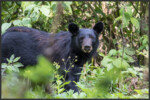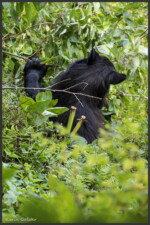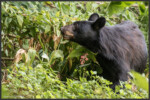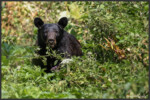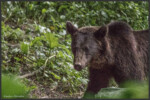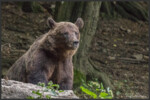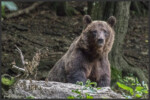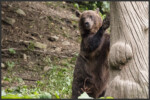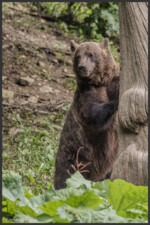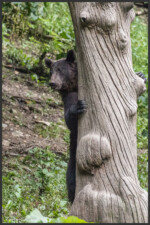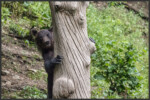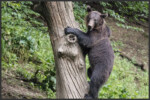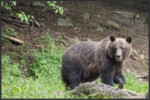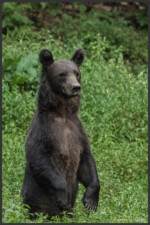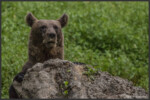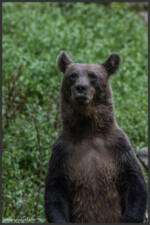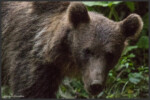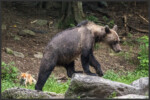Bears don’t seem to leave anybody indifferent, people’s reactions ranging from deep fascination and awe to total panick and blind fear. Bears are both very familiar animals (who didn’t have a teddybear at some point during their childhood?) and mysterious and elusive at the same time – not many people have been lucky enough to be able to observe one in the wild. Seeing a wild bear with my very own eyes, for many years I didn’t even dare to dream….
The eight species of bear that can be found alive around the globe today have been regrouped in the family Ursidae. Apart from the giant panda whose diet consists almost exclusively of bamboo, and the polar bear who feeds on fish and marine ammals, the other six species of bear are omnivore.
So far I have been fortunate enough to meet two subspecies of the brown bear as well as the black bear and all these encounters have been totally unforgettable…..
My first encounter with a bear in the wild dates back to the summer of 2018 when we spent our summer holidays in Romania, a country where a subspecies of the brown bear, the Eurasian brown bear (Ursus arctos arctos) is still relatively abundant to this day. Up until a few years earlier bears could even be found regularly rummaging through bins in the city of Brașov. Even if the bears showed no signs of aggression towards humans, the Romanian authorities have since relocated the scavenging bears (mainly young or lower rank individuals) to places more suited to their biological needs. In general wild bears in Europe are very shy and there is virtually no chance to come across one when hiking through bear country. We came to the conclusion that in the little time we had available the only way to get to see a wild bear was to sign up with a local guide. The owners of the small hotel we were staying at, in the middle of the Carpathian Mountains had been heavily involved in a conservation programme for the regions large carnivores (bear, lynx and wolf). This programme, which had been implimented over a period of 10 years came to an end in 2003. Ever since our hosts had continued to develop sustainable low-impact tourism in the region, conscious that this was a good way to educate locals about the importance and the value of their natural heritage and thus insure its conservation and protection in the long run. Together with the local hunting association they have built hides where bears can regularly be observed allowing their guests to sign up for an evening of ”bear watching”. This is how, one late afternoon we found ourselves settled in a hide overlooking a small clearing, together with a few other guests from the hotel as well as 2 rangers, waiting for the first bear to arrive. Luckily for some rather impatient souls, the bears didn’t keep us waiting for long! Three beautiful bears that the rangers identified by name were there in the clearing below, we hardly dared to breathe….
We also took some time to visit the bear sanctuary in Zărnești (Libearty Bear Sanctuary – https://millionsoffriends.org/en/libearty/about-the-sanctuary/ ), the biggest sanctuary of this kind in Europe. Numerous bears rescued from unscrupulous owners or zoos that kept them in tiny cages or on chains to attract tourists have found refuge in this sanctuary set on 69 ha of oak forest. In the name of ”tradition” bears were often kept at the back of hotels, restaurants or petrol stations in several Eastern European countries. Having spent all their life locked up in a tiny dirty cage, with little or inappropriate food, often drugged or physically abused to make them less dangerous or more obedient (some, like Max lost his eyesight, others had their canine teeth and claws amputated) none of these bears could ever have survived in the wild. It is hard to believe how anybody could inflict so much pain and suffering on any animal, and all that in the name of ”tradition”! Over the years no less than 116 bears have been rescued and found a new safe home at the sanctuary, where they could spend the rest of their days enjoying what they should have done all their life, feeling the grass underneath their feet, climbing trees, taking a swim….
During our stay in Canada we were able to meet another subspecies of the brown bear, the grizzly bear (Ursus arctos horribilis) as well as the black bear (Ursus americanus).
Once abundant across North America, the grizzly bear‘s present range covers less than half of its historical territories. As is the case with many other predators, habitat loss and excessive hunting are the main causes for the dramatic decline of its population. In parts of Canada and the US the grizzly is now listed as threatened or endangered. With a view to help reestablish the grizzly population various strategies have been elaborated such as the creation of protected zones with strict no-hunting policies and restricted public acces. The Khutzeymateen Grizzly Bear Sanctuary that we visited is an example.
The black bear (Ursus americanus) is the most common and the most widely distributed bear in North America and it can be found in virtually all of Canadas provinces. Black bears tend to be smaller than grizzlies. Their straight facial profile and the absence of a shoulder hump make it relatively easy to distinguish them from grizzly bears. They might appear heavy and somewhat clumsy, but black bears are remarkably agile. They are excellent swimmers and regularly climb trees to feed or to escape ennemies. Despite its name, coat colours of black bears vary considerably and can range in shade from blonde, cinnamon or light brown to chocolate brown, mocca and of course jet black.
Grizzly bears generally have a reputation for being more aggressive than the black bears, based no doubt on records of attacks in the past, some of them fatal. But even if, on the whole, attacks from black bears have been found to be less severe, both species can be very dangerous. However in the majority of cases attacks occur because of humans behaving inappropriately and rather than as a result of an overly aggressive animal. To help prevent conflicts between humans and both black bears and grizzlies, bear awareness programs have been put in place in many areas. Bears are very intelligent animals and once they have learned to associate humans with food, they don’t take long to realise that with a little aggression they will be able to extract a tasty dinner without too much effort. This is why feeding any wild animal is strictly prohibited as well as leaving behind packaging or left-overs. All bins have been rendered bear proof. Some hiking trails through bear territory may be closed for part of the year, during berry season for example, when bears are regularly found foraging near the trail. In order to avoid surprise encounters at very close range with a bear, or worse a mother bear with cubs, hikers are encouraged to travel in groups making loud noise and to carry a can of bear spray on them as a last resort. The number of conflicts has been considerably reduced since!
